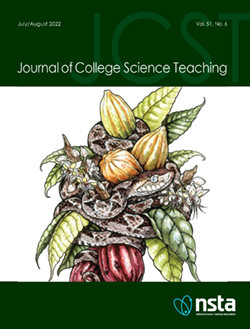Journal of College Science Teaching—July/August 2022

Volume 51, Number 6
This issue of JCST Research and Teaching column includes: an interesting interdisciplinary look at using arts-integrated professional development to enhance environmental education; a study showing that computer-based exams do not disadvantage students; how to use an argumentative writing prompt to support non-science majors in chemistry; the impact of faculty development on teaching about the interdependence of water, food and energy; a decision-making tool to promote information literacy; and a study on the impact of a co-taught physics course on preservice science teachers’ views of teaching physics. Our Features column has a STEM theme where you will find: an interesting article on Science, Society & Self, which takes a NOS look at imparting a social context to STEM, (EDITOR’S NOTE: I will be using this article in my own “Perspectives: Teaching in Today’s Society” class this year); an investigation using a human-centered design toolkit for STEM-based Capstone Courses in a Food Science Curriculum; and a STEM faculty experience at West Point. This issue’s special column on Remote Learning – Strategies in Response to the COVID-19 Pandemic article highlights the impact of online STEM teaching and learning during COVID-19 on underrepresented college students. The Point of View column shares the importance of operationalizing the duty of care with the use of rubrics to allow students to clearly understand safety expectations and competencies.
Journal Article
Operationalizing the Duty of Care Through Rubrics
Laboratory experiments are a key aspect of science education. However, they do have risks, and accidents do happen. Science educators have a duty of care, which includes duty of instruction. One tool that can be leveraged for duty of instruction is c...
By Emily Faulconer
Journal Article
Female students, students of color, first-generation students, and low-income students face considerable barriers in access to STEM education, leading to their underrepresentation in STEM fields. Ensuring that these students develop strong self-effic...
By Sami Kahn, Janet Vertesi, Sigrid Adriaenssens, Julia Byeon, Mona Fixdal, Kelly Godfrey, Jérémie Lumbroso, and Kasey Wagoner
Journal Article
A formal pedagogical push emerged and later blossomed in designing integrated curriculum between STEM and non-STEM areas in secondary and higher education. A growing cadre of research identifies positive learning outcomes for students participating i...
By Marcus Aldredge, Sunghee Lee, and Josh Klein
Journal Article
A Human-Centered Design Tool Kit for STEM-Based Capstone Courses
In fall 2019, a food science instructor partnered with the design center at a large Midwestern university to create a student activity tool kit for integrating the Human-Centered Design (HCD) approach into a science, technology, engineering, and math...
By Lucas O’Bryan, Dawn Bohn, and Saadeddine Shehab
Journal Article
The STEM Faculty Experience at West Point
At conferences or meetings, West Point faculty are often asked, “What’s it like to teach at West Point?” Previously, we reported on this question within the context of the cadet’s West Point experience and how STEM courses and opportunities a...
By Carolann Koleci, Eileen M. Kowalski, and Kenneth J. McDonald
Journal Article
From Science in the Art Gallery to Art in the Science Classroom
In this study, 26 teachers for kindergarten through Grade 8 in six schools participated in a comprehensive and interdisciplinary professional development (PD) effort focused on integrating environmental education across the curriculum. One focus of t...
By Lauren Madden, Carolina Blatt, Louise Ammentorp, Eileen Heddy, Dana Kneis, and Nicole Stanton
Journal Article
Computer-delivered exams are attractive due to ease of delivery, lack of waste, and immediate results. But before moving to computer-based assessments, instructors should consider whether they affect student performance and the student exam experienc...
By Deena Wassenberg, J.D. Walker, Kalli-Ann Binkowski, and Evan Peterson
Journal Article
An argumentative writing prompt model is presented for use in a general chemistry class designed for nonscience major students. The purpose of this instructional model is to support students with rich experiences to strengthen their conceptual unders...
By Claudia Aguirre-Mendez and Ying-Chih Chen
Journal Article
To support undergraduate instruction and learning outcomes (i.e., systems thinking and decision-making in interdisciplinary contexts) grounded in the Food-Energy-Water Nexus (FEW Nexus), we implemented a multiyear faculty development program around a...
By Amie S. Sommers, Holly White, Jenny M. Dauer, and Cory Forbes
Journal Article
An important facet of college students’ science literacy and job market preparation is developing skills for finding and applying information to decision-making about complex real-world problems. We developed a multidisciplinary science course to s...
By Jenny M. Dauer, Amanda E. Sorensen, and P. Citlally Jimenez
Journal Article
This article focuses on the impact of a physics class on secondary science teacher candidates’ views of teaching and learning physics. The course was developed and taught by faculty from the Department of Astronomy and Physics and the College of Ed...
By Kadir Demir, Brett Criswell, and William Stoll


